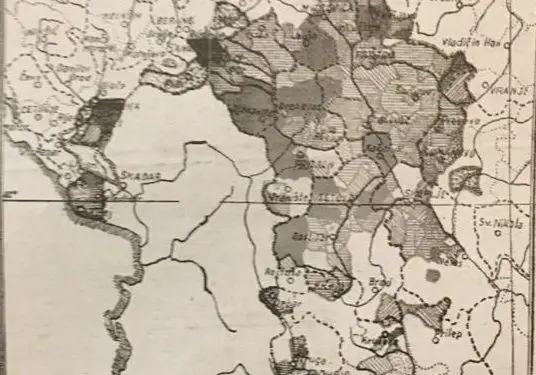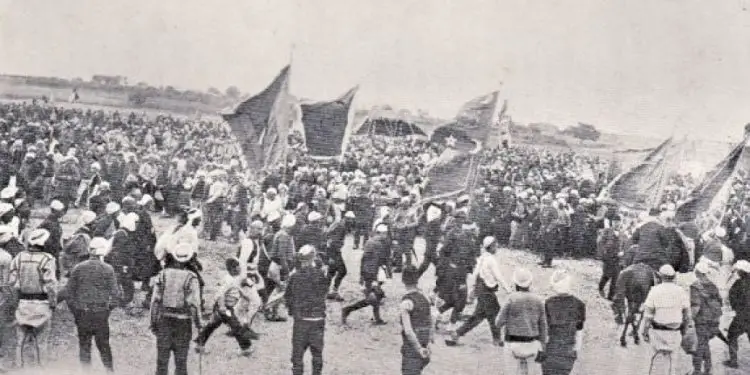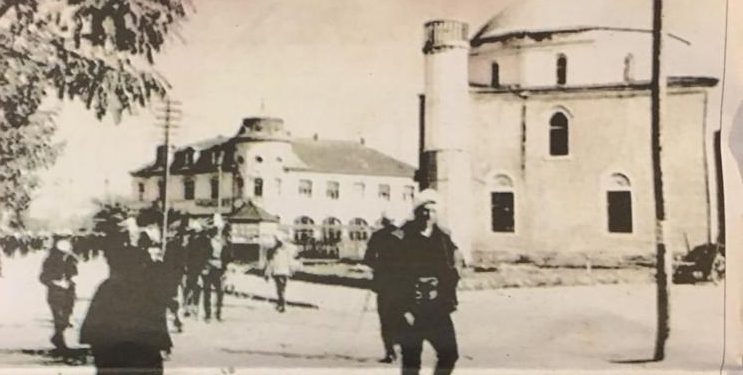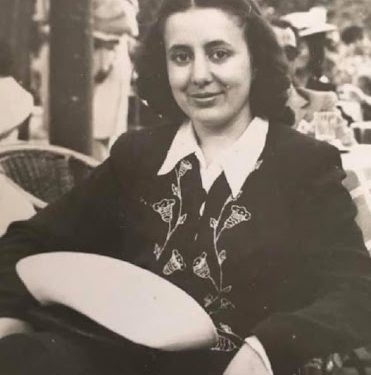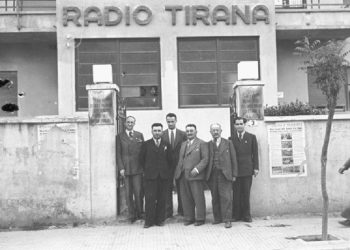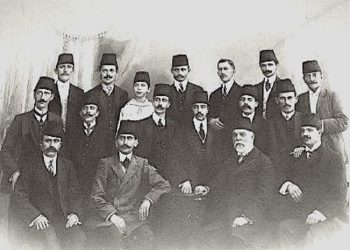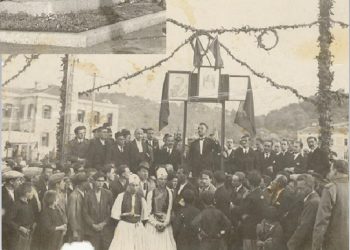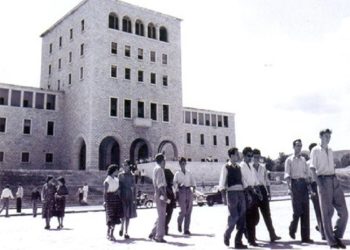Dashnor Kaloçi
Memorie.al publishes the unknown story of the book “Kosovo, the cradle of Albanianism” by the well-known intellectual, Hamit Kokalari, which was published in 1943 and was received with great interest, not only in the intellectual circles of Tirana but also in all Albanian territories where it was immediately disbanded. Kokalari was the suckling of one of the most famous and nationalist families in the city of Gjirokastra, who only a short time ago had served as a senior official in the local administration of Kosovo. The book in question had only 125 pages and consisted of about 27 chapters, where the author has used hundreds of references of Albanian authors, such as Fan Noli, Mit’hat Frashëri, Dom Luigj Gashi, Zef Fekeçi, Karl Gurakuqi, Xhaferr Belegu, etc. as well as foreigners such as Antonio Baldacci, Angelo Pernice, Edit Durham, Milan Shuflai, Justin Godard, Bernard Nevman, etc. Many of the study chapters of Kokalari are illustrated with special tables, which present data on the population of the Albanian territories occupied by the Slavs, as well as various maps published by well-known academics and institutes in Europe. The book in question was republished in 1961 in Italy by a group of Albanian nationalist intellectuals with a foreword by prof. Abaz Ermenji, while in Albania he never saw the light of publication, even though the author wrote a letter to Nexhmije Hoxha, from which he received a negative answer… ?! From that time onwards and in the years that followed, in order to secure a living, Hamiti dealt with various translations, as he was fluent in five or six foreign languages, and after a long illness, he passed away in 1989. , while his two brothers, Muntazi and Vesimi, were shot in 1944 by order of Enver Hoxha, and his sister, the famous intellectual, Musine Kokalari, passed away in 1984 in the city of Rrëshen, after many years in prison and internment.
At the beginning of 1943, less than two or three years after fascist Italy had recognized ethnic Albania, and had returned to it almost all Albanian lands, the Berlin Congress in 1878, as well as the London Conference in In 1913, she was unjustly separated and given to her neighbors, in the Albanian capital, Tirana, a book entitled “Kosovo, the cradle of Albanianism” was published. The author of this famous book that was received with extraordinary interest, not only in the intellectual circles of Tirana but also in all Albanian territories where it was immediately distributed, was a young intellectual, named Hamit Kokalari. He was the suckling of one of the most famous and nationalist families of the city of Gjirokastra, who only a short time ago had served as a senior official in the local administration of Kosovo. The book in question had only 125 pages and consisted of about 27 chapters, where the author has used many references of Albanian authors, such as Fan Noli, Mit’hat Frashëri, Dom Luigj Gashi, Zef Fekeçi, Karl Gurakuqi, Xhaferr Belegu, etc. as well as foreigners such as Antonio Baldacci, Angelo Pernice, Edit Durham, Milan Shuflai, Justin Godard, Bernard Nevman, etc. Many of the study chapters of Kokalari are illustrated with special tables, which present data on the population of the Albanian territories occupied by the Slavs, as well as various maps published by well-known academics and institutes in Europe. In addition to numerous references and archival documents with which he consulted, the author of the book in the preface has given special thanks to the great help he had given, Reuf Fico, one of the most famous Albanian politicians and diplomats of the half of first of the last century, who in the last years of his career, served as ambassador of the Albanian Kingdom of Zog, in Belgrade. From Kokalari’s book, “Kosovo, the Cradle of Albanians”, we have selected and are publishing in the original version, only a few parts of it, thinking that even more light is shed on the truth of Kosovo Albanians and other Albanian areas, which were unjustly detached from the parent trunk, in the mid-nineteenth century and the beginning of the second decade of the twentieth century.
Kokalari: Serbian documents also speak in favor of Kosovo
In the first pages of the book “Kosovo, the cradle of Albanians”, its author, Hamit Kokalari, has made a brief introduction, where he explained in a few words why he entered that study, and at the end of it, He thanked Mr. Reuf Fico (former diplomat and well-known politician, who at the end of his career served as ambassador of the Albanian Kingdom of Zog in Belgrade), for the assistance provided and for the documents he received to hand them over. In that preface, it is written: “Few people in Albania know Kosovo and other Albanian northern provinces that international treaties have pardoned Montenegro and Serbia in 1878 and 1913; it can be said that the history of Kosovo and its ethnographic issues are known only to some specialists. Books on these issues are not lacking, and especially in foreign languages they form a rich library and prove the Albanianness of the provinces in question from every point of view. It is enough to read for this purpose the books and documents published in the former Yugoslav kingdom. These documents acknowledge that the majority of the population in Kosovo is Albanian, no matter how hard they try to hide or diminish the number of Albanian countries. But what conclusion will be drawn in a census conducted with complete impartiality? If it were realized, it would be a very valuable document for us. Despite this, the documents prepared by the Serbs speak volumes in our favor, and in this publication, such documents will be taken as a basis. As an example, at the end of this study, a small amount of the endless series of publications in foreign languages on the Albanianness of Kosovo will be given as an example. But what is less known and deserves to be noted is the history of Kosovo. Kosovo has not only been the cradle of the Albanian Renaissance but has been especially the main factor of historical events that caused and ensured the creation of the Albanian state and our national freedom. Kosovo has been a permanent battlefield where Albanians have shed their blood for centuries in a double war against the Turks and the Serbo-Montenegrins. Particularly important historical events of the period of the Albanian League of Prizren (1877-1881), and those of the Kosovo Uprising (1909-1913), which resulted in the creation of the Albanian state, were almost entirely the work of Kosovars. Only Albania closed on the borders of 1913, had the good fortune to enjoy the reward of the atrocities committed by the Kosovo Albanians, who sadly, instead of gaining the deserved freedom, went from Turkish captivity to Serbia-Montenegro. On this occasion, I consider it my duty to thank all the friends who helped me in compiling this publication, and especially to express my deep gratitude to Mr. Rauf Fico, for the documents he had the kindness to submit to me “.
Hamit Kokalari’s study: Historical considerations
This study aims to capture, by means of a brief historical and ethnographic description, a general idea of those purely Albanian provinces of the north and northeast that had been sidelined by Serbia and Montenegro after the Russo-Turkish war of the year. 1877 and after the Balkan war and that during the Ottoman rule were part of the Vilayets of Shkodra, Kosovo, and Bitola. In the historical field, Serbian propaganda has unfortunately managed to do wonders, because it has been able to present Kosovo in front of the world opinion as to if it were a Serbian country. In this work, the work of Slavic propagandists was also supported by the assistance and full cooperation of the press and the literature of the great defensive powers of Serbia. Albanian propaganda, with its very modest means, did not have the desired effects to have stronger arguments and no matter how much reality itself spoke in favor of the Albanian thesis. One of the means of Serbian propaganda has been folklore. Serbs have exalted their wars in Kosovo in their folk songs, but Albanians have more reason to be proud of the wars they have waged against the Turks and against the Serbs in Kosovo, and these glorious deeds are mentioned in our folk songs. , which the Serbs themselves collected and published in Belgrade, in the magazine “Prilozi Proncevanje norodne poezie”.
The truth of the battle of Fushë Kosovë / Kosovo Polje in 1389
Serbian propaganda has used especially the battle of Kosovo (1389), which it has presented as an immortal myth of the Yugoslav national ideal and as an argument to prove Serbian claims in Kosovo. In fact, the battle of Kosovo, which the Serbs fought so hard to make all theories their own, took place between the Turks and a Christian coalition under the command of the Serbian king Lazarus, who fell dead in the ensuing war. It should be well explained that the battle of Kosovo was not the work of the Serbs alone, but of a Christian coalition, composed of Serbs, Albanians, Bulgarians, Bosniaks, Dalmatians, Hungarians. The Albanians were commanded by Prince Gjergj Kastrioti, the grandfather of our national hero, Skanderbeg, but the general command was entrusted to the Serbian king Lazarus, and this was done because none of the other allied armies were commanded by a king and because the Serbian army was larger in number. Serbian forces and allied armies fighting in the Kosovo area tried to stop the Turkish invasion with an expedition that was more of a crusade to cut off the Muslim threat than a national war. Historians recognize this battle as a new crusade against the Ottoman power that was added and threatened the Christian world of the accident. However, the Albanian forces in this battle brought the first-hand contribution: a crusade against Sultan Murad I. The crusading army, made up of Serbs, Bulgarians, Bosniaks, Albanians, Vlachs, Pollaks, and Hungarians, attempted with the Turkish armies in the Kosovo plain. In the war council held under the leadership of King Lazarus, Gjergj Kastrioti had proposed that the Turks fall at night, but this proposal was disliked because the enemies could escape a complete defeat and flee the most. dark. So they fell to the ground and were completely crushed by the Turks. Among those killed were Sultan Murad I himself and Theodore II Muzaka. (Skanderbeg’s History, by Fan S. Noli, Boston 1921, page 37).
Kosovo has never been Serbian land
Only luck and chance brought Serbs to choose Kosovo as a battlefield because in reality Kosovo has never been a real Serbian land and later in their claims Serbs, before and after the Balkan war could not prove that the province of Kosovo and other neighboring Albanian provinces were Slavic, and could not even prove it when they annexed Kosovo, because the number of Slavs there was too small. As for the expression “Stara Serbia”, i.e. “Old Serbia”, which Serbs usually use to call Kosovo that way, should be emphasized that the expression has no historical basis and that Serbs invented it themselves from the mid-19th century, to better serve the purposes of their passion to the detriment of Albania. This tactic was also used by the Bulgarians in their propaganda with the word Macedonia, which has remained as a geographical expression since ancient times and they have presented Macedonia as an irreducible Bulgarian land regardless of the existence of other ethnic elements. For example, Kaçanik, Presevo, Kumanovo, Skopje, Tetovo, Gostivar, Kichevo, Dibra, Struga, Ohrid, are presented as part of Bulgarian Macedonia, whose borders are arbitrarily marked and without any ethnic or geographical character. This system has also been used in the south by Greek propaganda with the word Epirus, which in reality in the old historical and literary documents is synonymous with Albania, just as the word Epirote shows everything that is Albanian or has to do with the Albanian language. The Albanian language is indicated by the words “Epirote language” and Skanderbeg is known in the past as the Prince of Epirus. , while strong Greek propaganda has erased these traces in front of the world opinion. Before and after the Balkan war, many Albanian provinces were annexed by Serbia, so much so that it can be said that a second Albania existed outside the political borders of Albania and had remained under the rule of the Serbs. All these provinces are usually called in the Albanian language; “Kosovo”, even when it comes to the provinces that are very far from “Kosovo Field”. As for Peja and Jakova (Gjakova, our note), it is known by us as part of Kosovo, and its real name in Albanian is “Dukagjin”. Foreigners used the name “Metohi”, as it is derived from the Greek and means church property. In order to strengthen the historical considerations, it should be remembered that in the events that took place in those Albanian provinces they have special importance. Before the arrival of the Romans and Slavs in the Balkans, the country was in the hands of the Illyrians, the ancestors of the Albanians, who stood out especially with their kings at the time of Teuta, with Shkodra as its capital, and Dardanis as its capital, Skopje. The Illyrian tribes and kings showed great vigor and occupied most of the Western Balkans. Especially the kingdom of Dardania, which included all of Kosovo and had Skopje as its center, has a player with an important historical role.
The Slavs retain the characteristics of the Illyrian race
When Rome occupied the lands of the Illyrians, they preserved their traditions and race, while the Slavic invasions that came later tried to assimilate them in every way, changing the language, customs, and religion, as well as giving Slavic names to the cities. and villages. For this reason, we find Slavs in the Balkans who still retain the characteristics of the Illyrian race and are more similar to Albanians than Serbs. In some areas, between Serbia and Albanian Kosovo, the population cannot be accurately identified whether it is Slavic or Albanian, as it speaks both languages and has mixed traditions and customs. As we will see below, Serbs themselves acknowledge that most of their compatriots still speak Serbian with an Albanian accent, which proves the Albanian origin of these populations. Albanian tribes have thus lost their existence before Slavic invasions and propaganda and have become Serbized… Thus we have the example of the Albanian tribes of Kuçi and Piper and Plava and Gucia that were later Serbized; We have such examples in Novi Pazar and in Senica. Also, some authors are of the opinion that the Montenegrin people have more affinity as a race with the Albanian people than with the Serbian people. Prominent Serbian people today are proud of their Albanian origins and proudly remember the names of the Albanian tribes from which they are descended. In the claims of the Slavs on the lands of the Albanians, the main argument is historical. Both Serbs and Bulgarians base their rights on medieval events when those peoples invaded Albania and Greece and established their own kingdoms, which in reality were more of a Slavic empire with a religious character that tried in every way to reach the Adriatic. The empires of these Slavic peoples had all short lives and were then forced to withdraw, leaving the natives the right to self-government and the lands they had attempted to colonize. An example We had a similar example in our century with Yugoslavia, which in reality was an empire that wanted to rule different peoples, such as Croats, Bosniaks, Montenegrins, Hungarians, Romanians, Macedonians, and Albanians. The desire for rule reached the point where a large-scale colonization work began in Kosovo, a work which in this century and in the middle of Europe was an enterprise against every human principle and modern civilization, especially if we consider the methods with which were implemented. Serbs and Bulgarians try to justify their consolidation revisions and programs with the existence of a church left over from the past and reminiscent of the short rule of their kings in Kosovo or Macedonia, regardless of the fact that Albanians are an autochthonous population. and that more than any other people have irrigated this land with their sweat and the blood they have shed in the many uprisings they have waged against the Serbs and Turks. On the other hand, to be even more objective, it can be said that the various invasions of Serbs and Bulgarians in the Western and Southern Balkans fall into the category of many other invasions that Europe and the Balkans saw in medieval times with this change that Serbs and the Bulgarians settled in the Balkans forever, but this could not allow them to eat the rights of neighboring peoples, much less indigenous peoples. After the Turks conquered the Balkans and their rule stabilized for nearly five centuries, the Albanians were not only not assimilated by the new ruler but strengthened their position and race. At the beginning of the conquest of the Balkans, the Turks found the strongest resistance in the Albanian people who continued the war for nearly a century, for a longer time, and in a better way than the other peoples of the Balkans. Especially Skanderbeg’s persistent and unbreakable resistance convinced the Turks that they were dealing with a sound element, which they tried to assimilate only from a religious point of view and keep it alive as a race so that the Albanian people became a pillar. resistance to Slavic danger. The Slavic peoples, however, defeated, continued their expansion to the detriment of other neighboring peoples. If the Albanians had not converted to Islam, all Slavs would have been assimilated; thus only a few tribes were assimilated and most escaped. Kosovo Albanians, who were the vanguard of the race, thus waged a double and centuries-long war against the Turkish rule that you are trying to defeat as much as possible and against the infiltration and assimilation work that the Slavs were carrying out through religion and propaganda. Against the Turks who tried to defeat them even more, the Albanians rebelled from time to time, as evidenced by the fifty-four Albanian insurgent movements recorded by Turkish history, of which that of 1668, which erupted in Mitrovica, is particularly notable. because all Kosovars took part in it. This movement extended beyond Skopje and threatened the Thessaloniki route (Tarih-Eb yl Farruk, page 13).
The Berlin Congress that divided Albania
Still in Kosovo, there are later enterprises for the revival of the Albanian homeland. The historical fact that resumed the Albanian renaissance took place in the vilayet of Kosovo, in Prizren, where the famous League called the League of Prizren (1878) was founded. From Kosovo began to develop the branches of this magnificent organization that as a spark spread to the impulse of national feeling in all parts of Albania. Kosovars were the main elements of the League that implemented the program of protection of Albanian interests by fighting against Montenegrins, Serbs, and Greeks. The creation of the League was caused by the treaty of St. Stephen (1878), which was then revised in Berlin. Albanian leaders from all over Kosovo and Albania decided to attend the League meeting in Prizren: to save especially the Homeland from the fragmentation decreed by the Berlin Congress in favor of neighboring nations; secondly, to impose on the Ottoman Government the autonomy of Albania within the administrative borders of the four vilayets of Ioannina, Bitola, Skopje, and Shkodra, with Ohrid as its capital, and finally to prepare the nation for the final war, for its complete independence. In addition, the League sent its delegates to the Berlin Congress, but their statements were not even heard, as there were no people at the meeting to show goodwill to avoid the evils reserved for Albania. So it was decided at that Congress the partition of Albanian lands satisfy the greed of Serbs, Montenegrins, and Greeks. But the will of the armed Albanians did not deviate from this unjust decision; to maintain Albanian territorial integrity, the League opposed with all its might and proud resistance. Albanian forces fought bravely in Plava and Gusi and saved those provinces from the Montenegrin yoke. So they fought in Hot and Grude as well as in Ulcinj where Europe was forced to send an international fleet to threaten the Albanians and on the other hand forced the Sultan to make an expedition to condemn the Albanian insurgents who had decided better to die than to release a handful of the land of their country./Memorie.al
Follows tomorrow







